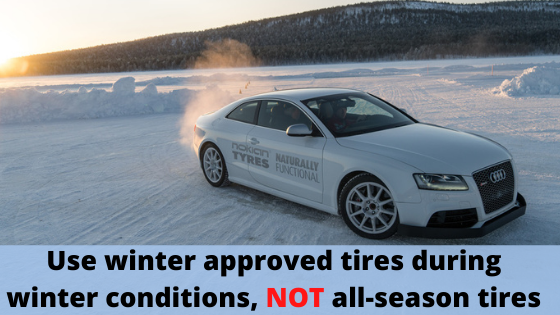Driving during autumn can be a beautiful experience as it can be very colorful with the changing colors of the leaves. You are however moving from some of the easiest driving conditions with dry and clean roads and heading into more unstable weathers and potentially even snow and ice. The weather before the winter arrives can also be challenging as you will have both temperature drops, decreasing visibility due to shorter days and longer nights and a lot of unstable weather. Rain will increase and the heavy autumn rain can easily cause hydroplaning. The risk for hydroplaning increases with bad tires, tires that are approaching its worn-out state.
During fall you can also experience snowstorms, where you get snow and slush to cause slippery conditions. Here you have to make sure that you have winter approved tires to be able to cope with these conditions. You then also have to worry about slushplaning that can happen when you have wet snow and rainy conditions when you have snow on the ground. Slushplaning is in the same way as hydroplaning is dangerous and you can easily lose control over your vehicle.
It is not advisable to wait with buying a new set of tires, especially not as you are heading into more challenging driving conditions. As soon as you reach 5/32 inches of tread depth it is time to change the tires to a new set. You have much worse properties once you go below this threshold. Your braking distance will be prolonged making it more likely to be in an accident. You also have a higher likelihood of hydroplaning. This turns the fall into dangerous driving territory. So even if you plan to change to winter tires in a few weeks, you should already now buy a new set of all-season tires, so that you can keep your cars out of accidents and you will also start next summer season with almost a brand new set of tires. For winter tires it is even more important that you ensure that you have sufficient tread depth so that you can drive safely on snow and slush.
All-season tires are designed for both dry and wet roads, so the rain shouldn’t cause you that much problems if you have good quality tires and that they are in good condition. You should though always adjust your driving according to the weather conditions and make sure that you reduce your speed accordingly. You reduce your chance for hydroplaning when the speed is reduced. You should also monitor the temperature and make sure to change to winter tires early enough. The winter tires are better than all-season tires when the temperature drops below 45 degrees Fahrenheit.
Therefore, you should make sure that you always have good quality tires that are in good condition. This will improve your safety regardless of what season you drive in. Remember to also change to winter tires before the winter weather arrives and respect the heavy rain as it can lead to hydroplaning.
For more information regarding tires for autumn, visit: nokiantires.com
